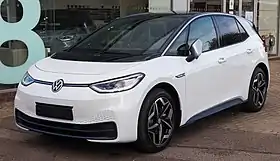Volkswagen ID.3
The Volkswagen ID.3 is a compact (C-segment) electric car produced by Volkswagen based on the MEB platform (German: Modularer E-Antriebs-Baukasten; English: modular electric-drive toolkit)[7] and the first model of the ID. Series (Intelligent Design).[8] It was unveiled on 9 September 2019 at the Frankfurt Motor Show, after being first shown as the I.D. concept car at the 2016 Paris Motor Show. Deliveries to retail customers began in Germany in September 2020.[1] Almost 57,000 units were delivered in 2020, ranking among the world's top 10 best selling plug-in cars with just four months in the market.[9]
| Volkswagen ID.3 | |
|---|---|
 Volkswagen ID.3 1st | |
| Overview | |
| Manufacturer | Volkswagen |
| Production | 2019–present[1][2][3] |
| Assembly | Germany: Zwickau (Zwickau-Mosel Plant);[3] Dresden (Transparent Factory)[4] |
| Designer | Marc Lichte (concept) Klaus Zyciora |
| Body and chassis | |
| Class | Small family car hatchback (C) |
| Body style | 5-door hatchback |
| Layout | Rear motor, rear-wheel drive |
| Platform | Volkswagen Group MEB |
| Related | Cupra el-Born |
| Powertrain | |
| Electric motor | APP 310 Permanent Magnet Brushless motor |
| Transmission | Single-speed |
| Battery |
|
| Electric range | |
| Plug-in charging |
|
| Dimensions | |
| Wheelbase | 2,765 mm (108.9 in) |
| Length | 4,262 mm (167.8 in) |
| Width | 1,809 mm (71.2 in) |
| Height | 1,552 mm (61.1 in) |
| Curb weight | 1,600 kg (3,500 lb) |
| Chronology | |
| Predecessor | Volkswagen e-Golf |
I.D. Concept
The ID.3 was previewed as a concept car called the Volkswagen I.D. with hatchback body type. and was first shown at the September 2016 Paris Motor Show. It was the first concept model of the new all-electric I.D. sub-brand. According to Volkswagen, the I.D. featured innovations such as virtual wing mirrors (using video cameras), "chocolate bar" battery design, and retractable LiDAR sensors used for autonomous driving,[10] not all of which made it to the production version.
.jpg.webp) Volkswagen I.D. Concept at IAA 2017
Volkswagen I.D. Concept at IAA 2017.jpg.webp) Volkswagen I.D. Concept at Geneva Motor Show 2018
Volkswagen I.D. Concept at Geneva Motor Show 2018
Production model
In May 2019, Volkswagen confirmed the production model based on this prototype was named Volkswagen ID.3, instead of the rumoured I.D. Neo name,[11] and officially presented at the International Motor Show Germany in September 2019.[12] The ID.3 is one of five new Volkswagen models based on the MEB platform. Smaller cars bearing the ID.1 and ID.2 names are expected, and bigger models will range from ID.4 to ID.9. Volkswagen has also applied for trademark protection of an additional "X", supposedly for a SUV.[13] Reservations (€1000) for the launch model of the ID.3 started on the 8 May 2019, which were set to be delivered in midyear 2020,[6] whereas the base model, expected to cost under €30,000, will be delivered in 2021. Volkswagen names high expected demand as a reason.[14] It received 10,000 buyer reservations within 24 hours after the opening[15] and 30,000 before the unveiling at IAA 2019.[16] Retail deliveries began in Germany in September 2020.[1]
The production version of the ID.3 was unveiled on 9 September 2019 at the Frankfurt Motor Show (IAA), along with the new Volkswagen logo and branding.[17] The cars are assembled at Volkswagen's Zwickau factory, where the company expects the full plant capacity (330,000 cars per year) to produce electric cars based on the MEB platform for the Volkswagen Group from 2021 onwards.[18][19][20]
.jpg.webp) Rear view
Rear view Volkswagen ID.3 1st (side view)
Volkswagen ID.3 1st (side view) Interior
Interior
Specifications
Three different battery choices will be offered with the ID.3.
| Name | Net capacity | Gross capacity | Number of seats | WLTP range[5] | Real world range[6] | Charging power (AC) | Charging power (DC) |
|---|---|---|---|---|---|---|---|
| Pure | 45 kWh | 48 kWh | 5 | Up to 330 km (205 mi) | 230 to 330 km (145–205 mi) | 7.2 kW | 50 kW (100 kW option) |
| Pro | 58 kWh | 62 kWh | 5 | Up to 420 km (260 mi) | 300 to 420 km (185–260 mi) | 11 kW | 100 kW |
| Pro S | 77 kWh | 82 kWh | 4 | Up to 550 km (340 mi) | 390 to 550 km (240–340 mi) | 11 kW | 125 kW |
The 77 kWh variant will seat 4, the others 5, and all but the 77 kWh variant will have an optional panoramic roof that can be combined with a bike rack on a support hook at the back.[21]
The MEB platform will support up to 125 kW charging using CCS.[22] The 58 kWh version is said to support 100 kW charging.[6]
The drag coefficient of the car is 0.267, frontal area is 2.36 square meters, and the minimum turning circle is 10.2 metres (33 ft).[23]
It was first available in 3 different launch trim levels, namely ID.3 1st, ID.3 1st Plus and ID.3 1st Max. The battery size and powertrain remain the same across all 3 trim levels, however there are different levels of equipment, styling options and wheels. The wheels provided are: 18 in (460 mm) for ID.3 1st (215/55R18), 19 in (480 mm) for ID.3 1st Plus (215/50R19) and 20 in (510 mm) for ID.3 1st Max (215/45R20).
Software issues
In early 2020 it was announced that delivery of the ID.3 was going to be delayed until at least September 2020 due to software errors that VW had yet to be able to resolve. Some stripped down cars were delivered in September with cloud connected ones being delivered at the end of 2020.[24][25]
See also
References
- Kane, Mark (2020-09-11). "Volkswagen Starts Deliveries Of ID.3 1ST". InsideEVs.com. Retrieved 2020-09-14.
- Alys Key: Volkswagen starts production at electric car plant in Germany, inews, 4 November 2019
- "Production of ID.3 at Zwickau plant to start in November". Volkswagen Newsroom. Volkswagen AG. 6 September 2019. Retrieved 6 September 2019.
- "Volkswagen ID.3 production starts at Transparent Factory in Dresden, which will be 'Home of the ID' - paultan.org". Paul Tan's Automotive News. 2021-02-01. Retrieved 2021-02-01.
- "Vision made reality: world premiere of the ID.3". Volkswagen Newsroom. Volkswagen AG. 9 September 2019. Retrieved 9 September 2019.
- "Now you can: the new ID.3 1ST". Volkswagen. Volkswagen AG. Archived from the original on 19 November 2019. Retrieved 6 September 2019.
- "Meet the Volkswagen platform designed to spawn 10 million electric vehicles". Newsroom. Retrieved 2020-11-14.
- "First member of the ID. family is called ID.3". www.volkswagenag.com. Retrieved 2020-11-14.
- Jose, Pontes (2021-02-02). "Global Top 20 - December 2020". EVSales.com. Retrieved 2021-02-03.
- "Fully Charged - VW ID Buzz". YouTube. Retrieved 24 May 2019.
- "Volkswagen offers pre-booking for the first time". Volkswagen Newsroom. Retrieved 24 May 2019.
- Ltd, Newspress. "Revolutionary Volkswagen I.D. Electric Concept Car Makes Its World Debut At The Paris Motor Show: Volkswagen Media Centre". Volkswagen Media Centre.
- Holger Wittich, Thomas Harloff (2019-10-14). "VW ID.1 und ID.2 (2023)" (in German).
- Schwuchow, Oliver (2019-03-12). "VW ID.3: Elektroauto kann ab dem 8. Mai vorbestellt werden".
- https://techcrunch.com/2019/05/09/vws-new-electric-hatchback-receives-10000-pre-orders-in-first-24-hours
- "More than 30,000 reservations for the ID.3 1ST edition". Volkswagen Newsroom. Volkswagen AG. 4 September 2019. Retrieved 6 September 2019.
- "Volkswagen unveils new brand design and logo". Volkswagen Newsroom. 2019-09-09.
- Werwitzke, Cora (2018-11-15). "VW fertigt in Zwickau künftig 330.000 E-Modelle pro Jahr". electrive.net (in German).
- Kane, Mark (2021-01-30). "Volkswagen Group: Five Plants Already Produce MEB-Based EVs". insideevs.com. Retrieved 2021-02-05.
- "Our Volkswagen ID.3 Factory Tour Photo Album". CleanTechnica. 6 November 2019.
- Kane, Mark (2020-01-13). "VW Confirms ID.3 With Biggest Battery Seats Only Four: New Details". insideevs.com. Retrieved 2020-02-22.
- "All about the MEB". Volkswagen. 2019-09-18.
- "World premiere of the fully electric ID.3: The First ID. family vehicle debuts for the European market" (Press release). Wolfsburg/Frankfurt: Volkswagen of America. 9 September 2019. Archived from the original on 31 January 2021. Retrieved 31 January 2021.
- Shilling, Erik. "Volkswagen Has Bungled The Launch Of Its Most Important Car In Decades". Jalopnik. Retrieved 16 June 2020.
- Boston, William. "Volkswagen Delays Key Electric Car Launch Amid Software Troubles". Wall Street Journal. Retrieved 16 June 2020.
| Wikimedia Commons has media related to Volkswagen ID.3. |
